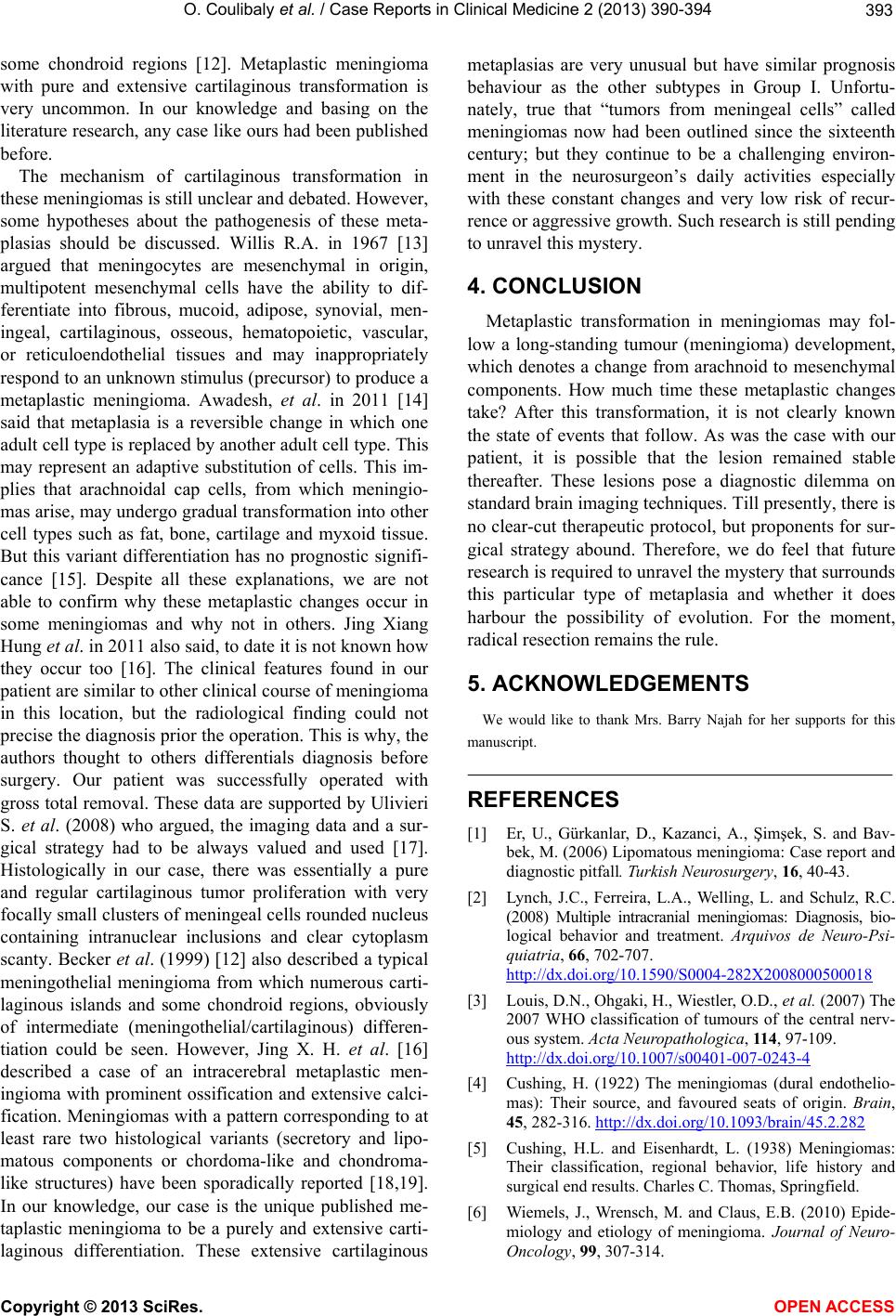
O. Coulibaly et al. / Case Reports in Clinical Medicine 2 (2013) 390-394
Copyright © 2013 SciRes. OPEN ACCESS
393
some chondroid regions [12]. Metaplastic meningioma
with pure and extensive cartilaginous transformation is
very uncommon. In our knowledge and basing on the
literature research, any case like ours had been published
before.
The mechanism of cartilaginous transformation in
these meningiomas is still unclear and debated. However,
some hypotheses about the pathogenesis of these meta-
plasias should be discussed. Willis R.A. in 1967 [13]
argued that meningocytes are mesenchymal in origin,
multipotent mesenchymal cells have the ability to dif-
ferentiate into fibrous, mucoid, adipose, synovial, men-
ingeal, cartilaginous, osseous, hematopoietic, vascular,
or reticuloendothelial tissues and may inappropriately
respond to an unknown stimulus (precursor) to produce a
metaplastic meningioma. Awadesh, et al. in 2011 [14]
said that metaplasia is a reversible change in which one
adult cell type is replaced by another adult cell type. This
may represent an adaptive substitution of cells. This im-
plies that arachnoidal cap cells, from which meningio-
mas arise, may undergo gradual transformation into other
cell types such as fat, bone, cartilage and myxoid tissue.
But this variant differentiation has no prognostic signifi-
cance [15]. Despite all these explanations, we are not
able to confirm why these metaplastic changes occur in
some meningiomas and why not in others. Jing Xiang
Hung et al. in 2011 also said, to date it is not known how
they occur too [16]. The clinical features found in our
patient are similar to other clinical course of meningioma
in this location, but the radiological finding could not
precise the diagnosis prior the operation. This is why, the
authors thought to others differentials diagnosis before
surgery. Our patient was successfully operated with
gross total removal. These data are supported by Ulivieri
S. et al. (2008) who argued, the imaging data and a sur-
gical strategy had to be always valued and used [17].
Histologically in our case, there was essentially a pure
and regular cartilaginous tumor proliferation with very
focally small clusters of meningeal cells rounded nucleus
containing intranuclear inclusions and clear cytoplasm
scanty. Becker et al. (1999) [12] also described a typical
meningothelial meningioma from which numerous carti-
laginous islands and some chondroid regions, obviously
of intermediate (meningothelial/cartilaginous) differen-
tiation could be seen. However, Jing X. H. et al. [16]
described a case of an intracerebral metaplastic men-
ingioma with prominent ossification and extensive calci-
fication. Meningiomas with a pattern corresponding to at
least rare two histological variants (secretory and lipo-
matous components or chordoma-like and chondroma-
like structures) have been sporadically reported [18,19].
In our knowledge, our case is the unique published me-
taplastic meningioma to be a purely and extensive carti-
laginous differentiation. These extensive cartilaginous
metaplasias are very unusual but have similar prognosis
behaviour as the other subtypes in Group I. Unfortu-
nately, true that “tumors from meningeal cells” called
meningiomas now had been outlined since the sixteenth
century; but they continue to be a challenging environ-
ment in the neurosurgeon’s daily activities especially
with these constant changes and very low risk of recur-
rence or aggressive growth. Such research is still pending
to unravel this mystery.
4. CONCLUSION
Metaplastic transformation in meningiomas may fol-
low a long-standing tumour (meningioma) development,
which denotes a change from arachnoid to mesenchymal
components. How much time these metaplastic changes
take? After this transformation, it is not clearly known
the state of events that follow. As was the case with our
patient, it is possible that the lesion remained stable
thereafter. These lesions pose a diagnostic dilemma on
standard brain imaging techniques. Till presently, there is
no clear-cut therapeutic protocol, but proponents for sur-
gical strategy abound. Therefore, we do feel that future
research is required to unravel the mystery that surrounds
this particular type of metaplasia and whether it does
harbour the possibility of evolution. For the moment,
radical resection remains the rule.
5. ACKNOWLEDGEMENTS
We would like to thank Mrs. Barry Najah for her supports for this
manuscript.
REFERENCES
[1] Er, U., Gürkanlar, D., Kazanci, A., Şimşek, S. and Bav-
bek, M. (2006) Lipomatous meningioma: Case report and
diagnostic pitfall. Turkish Neurosurgery, 16, 40-43.
[2] Lynch, J.C., Ferreira, L.A., Welling, L. and Schulz, R.C.
(2008) Multiple intracranial meningiomas: Diagnosis, bio-
logical behavior and treatment. Arquivos de Neuro-Psi-
quiatria, 66, 702-707.
http://dx.doi.org/10.1590/S0004-282X2008000500018
[3] Louis, D.N., Ohgaki, H., Wiestler, O.D., et al. (2007) The
2007 WHO classification of tumours of the central nerv-
ous system. Acta Neuropathologica, 114, 97-109.
http://dx.doi.org/10.1007/s00401-007-0243-4
[4] Cushing, H. (1922) The meningiomas (dural endothelio-
mas): Their source, and favoured seats of origin. Brain,
45, 282-316. http://dx.doi.org/10.1093/brain/45.2.282
[5] Cushing, H.L. and Eisenhardt, L. (1938) Meningiomas:
Their classification, regional behavior, life history and
surgical end results. Charles C. Thomas, Springfield.
[6] Wiemels, J., Wrensch, M. and Claus, E.B. (2010) Epide-
miology and etiology of meningioma. Journal of Neuro-
Oncology, 99, 307-314.